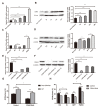Helicobacter pylori-Induced Progranulin Promotes the Progression of the Gastric Epithelial Cell Cycle by Regulating CDK4
- PMID: 35880418
- PMCID: PMC9628913
- DOI: 10.4014/jmb.2203.03053
Helicobacter pylori-Induced Progranulin Promotes the Progression of the Gastric Epithelial Cell Cycle by Regulating CDK4
Abstract
Helicobacter pylori, a group 1 carcinogen, colonizes the stomach and affects the development of stomach diseases. Progranulin (PGRN) is an autocrine growth factor that regulates multiple cellular processes and plays a tumorigenic role in many tissues. Nevertheless, the mechanism of action of PGRN in gastric cancer caused by H. pylori infection remains unclear. Here, we investigated the role of PGRN in cell cycle progression and the cell proliferation induced by H. pylori infection. We found that the increased PGRN was positively associated with CDK4 expression in gastric cancer tissue. PGRN was upregulated by H. pylori infection, thereby promoting cell proliferation, and that enhanced level of proliferation was reduced by PGRN inhibitor. CDK4, a target gene of PGRN, is a cyclin-dependent kinase that binds to cyclin D to promote cell cycle progression, which was upregulated by H. pylori infection. We also showed that knockdown of CDK4 reduced the higher cell cycle progression caused by upregulated PGRN. Moreover, when the PI3K/Akt signaling pathway (which is promoted by PGRN) was blocked, the upregulation of CDK4 mediated by PGRN was reduced. These results reveal the potential mechanism by which PGRN plays a major role through CDK4 in the pathological mechanism of H. pylori infection.
Keywords: CDK4; Helicobacter pylori; PGRN; cell cycle; gastric epithelial cells.
Conflict of interest statement
The authors have no financial conflicts of interest to declare.
Figures






